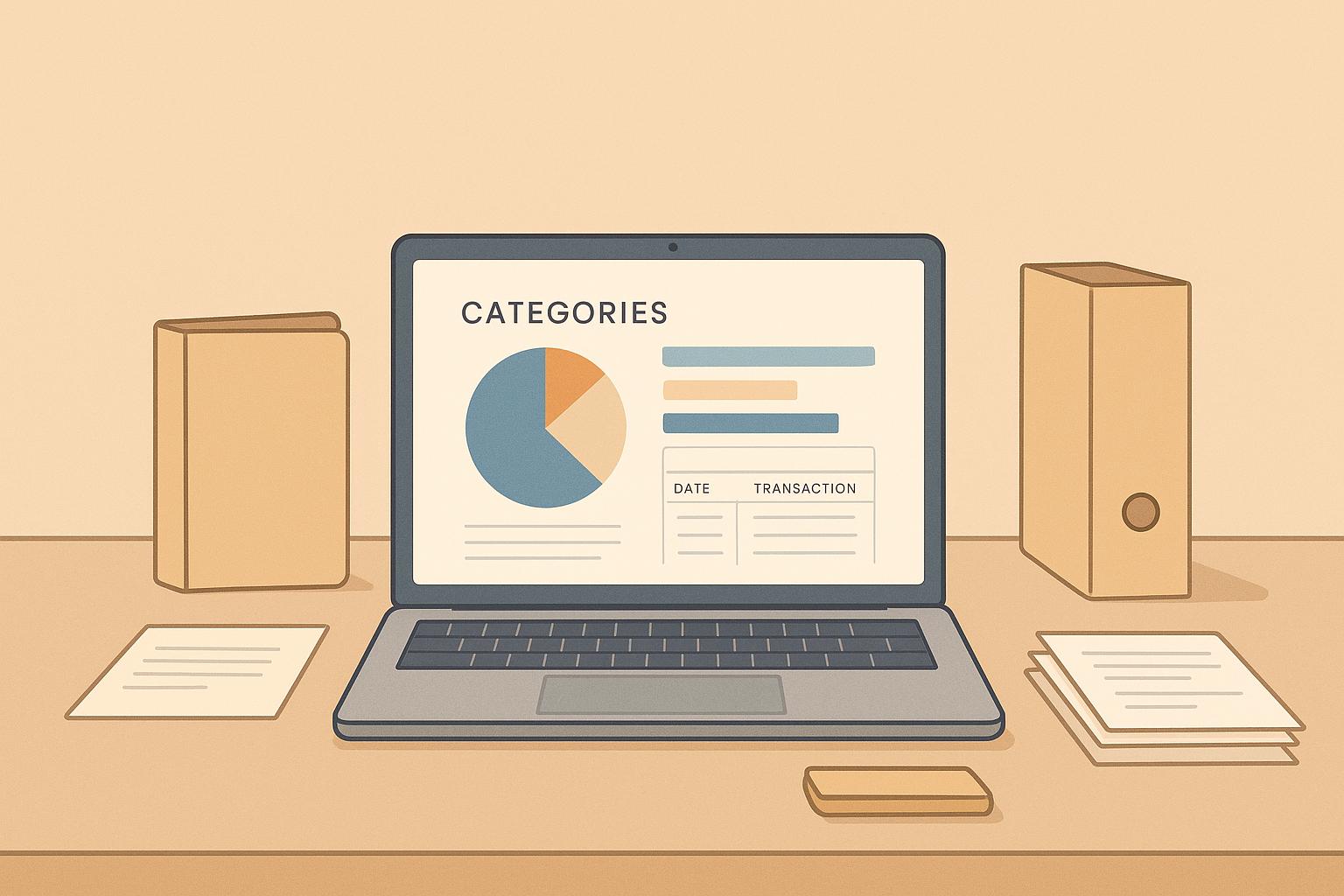AI is changing accounting. It automates repetitive tasks, reduces errors, and helps accountants focus on advisory work. Small and mid-sized firms can now access tools once available only to big companies.
Key Takeaways
- Save Time: AI automates data entry, document collection, and transaction categorization.
- Improve Accuracy: AI reduces errors in reconciliations and financial reporting.
- Boost Efficiency: Month-end closings are faster, and real-time insights improve decision-making.
- Easy Integration: Tools like QuickBooks and Xero work seamlessly with AI solutions.
- Cost Considerations: Start small with affordable tools and scale as needed.
AI is transforming accounting into a faster, more accurate, and client-focused profession. Start by automating one task, like invoice processing, and build from there.
15 AI Tools Smart Accountants Are Using Right Now
How AI Helps with Common Accounting Tasks
AI is transforming accounting by automating tedious tasks, allowing professionals to spend more time on analysis and client advisory services. It can reduce manual data entry by as much as 40% - a game changer for firms handling hundreds of transactions every month. This shift not only saves time but also enhances processes like document collection, transaction categorization, and reconciliation.
Auto-Collecting Documents
Gathering documents has always been a major challenge in accounting. AI simplifies this by automatically collecting and digitizing receipts, invoices, and bank statements through tools like OCR (optical character recognition), email transfers, and secure file uploads. Once the documents are digitized, the system extracts key details and organizes them into structured databases, cutting down on manual entry and reducing errors. Security is also a priority - AI systems ensure that only authorized users can access sensitive files. This streamlined process eliminates delays and avoids the chaos of month-end document collection.
Auto-Sorting Transactions
AI takes the guesswork out of categorizing transactions by learning a firm’s specific expense patterns. By analyzing historical data and user behavior, it can accurately assign categories and even adapt to unique vendor trends. The impact is substantial - Deloitte found that AI-powered reconciliation can reduce the time spent on this task by up to 70%. Tools like Relay Financial’s Accounting Automation system integrate with platforms like QuickBooks and Xero to analyze past transaction data and intelligently assign categories, significantly easing the workload during month-end reconciliation.
Faster Reconciliation and Month-End Closing
Reconciliation and month-end closing are traditionally time-consuming and stressful for accounting teams. AI simplifies these processes by automating transaction matching, identifying discrepancies, and even drafting journal entries. For example, it can compare transactions across multiple systems, flag inconsistencies, and suggest adjustments for review. These automated systems can cut month-end closing times by up to 85% while achieving a 98.6% accuracy rate in transaction matching, freeing up finance teams to focus on higher-level tasks.
AI also handles recurring journal entries with ease. For instance, if a company regularly records depreciation or accrued interest, the AI can prepare these entries automatically, leaving only final approval to the accountant. Companies like Blackbaud have demonstrated these benefits firsthand. In Q1 2025, Blackbaud integrated multiple systems into Workday, reducing journal entries by over 25% and streamlining manual processes. This shift enabled faster and more precise financial analysis.
The trend toward real-time reconciliation is growing, with 75% of accountants in small and medium-sized businesses predicting that real-time financial data will eventually replace traditional month-end closes. Already, 71% of organizations using advanced automation are closing their books in six days or less, compared to just 23% of those relying on minimal automation. AI is clearly paving the way for a more efficient and proactive approach to accounting.
Connecting AI with QuickBooks and Xero

AI-powered tools are transforming accounting workflows while seamlessly integrating with trusted platforms like QuickBooks and Xero. These systems, long favored by small and mid-sized accounting firms across the U.S., now benefit from AI enhancements designed to simplify processes and reduce manual effort.
By automating repetitive tasks - such as data entry, transaction categorization, reconciliation, and invoice processing - these integrations allow teams to stick with their preferred software while AI handles the heavy lifting behind the scenes.
Choosing Easy Integration Options
When incorporating AI tools into your accounting practice, look for solutions that are easy to set up. Plug-and-play options are ideal because they sync data between systems without requiring advanced technical skills or coding knowledge.
For QuickBooks users, built-in AI features like Intuit Assist offer significant advantages. Businesses using Intuit Assist report getting paid 45% faster on average. Personalized invoice reminders help them receive payments five days sooner than traditional methods, and the likelihood of overdue invoices being paid in full increases by 10%.
If you’re looking to expand beyond QuickBooks' native AI capabilities, platforms like Zapier and Tray.io can help. These tools offer connectors that integrate QuickBooks, Xero, and other applications. For example, Tray.io simplifies the process of linking multiple services.
Xero users also benefit from AI-powered features such as receipt and invoice scanning, automatic coding, bank and invoice reconciliation, accounts payable automation, and forecasting analytics. These tools not only handle repetitive tasks with precision but also analyze data to uncover patterns and anomalies, reducing the risk of error or fraud.
The integration process is typically straightforward: choose your accounting software, connect via an API or prebuilt connector, map data fields, configure workflows, and test everything before going live. Once set up, these integrations provide real-time insights into profit and loss, accurate cash flow projections, and quicker month-end closings.
Ensuring Data Security and Accuracy
While AI integrations offer numerous benefits, data security and accuracy are critical. These tools use advanced encryption and secure API connections to protect data during transfers.
Accuracy is especially important when AI automates tasks like transaction categorization and reconciliation. It’s essential to map data fields carefully to ensure smooth data flow between systems without errors or loss. Running multiple tests that simulate real-world scenarios and edge cases can help validate stability and accuracy.
Real-time monitoring tools further enhance integration reliability. These tools track data flow, system performance, API health, and error logs, allowing issues to be identified and resolved before they affect financial reporting. For firms dealing with VAT and e-invoicing requirements, integration tools can also manage multi-tax configurations and ensure compliance with applicable regulations.
Thorough testing - covering unit, integration, performance, and user acceptance - is crucial to confirm system stability and data accuracy. Together, these measures ensure that AI integrations streamline accounting processes while keeping your data secure, precise, and readily available for decision-making.
sbb-itb-ca9a050
How to Add AI Tools to Your Accounting Work
Bringing AI into your accounting practice doesn't have to be overwhelming. The key is to start small, focus on areas where automation can make the biggest impact, and build on those early successes.
Finding Your Biggest Time Wasters
Before diving into AI, take a close look at where your team spends the most time. Track your workflows for a couple of weeks to pinpoint repetitive tasks like data entry, invoice processing, bank reconciliations, and chasing down missing documents. These are often the easiest areas to streamline with AI tools.
Repetitive tasks, such as entering vendor information or categorizing transactions, can eat up a surprising amount of time each week. These are prime candidates for automation. But before jumping in, evaluate your team's technical skills, the quality of your data, and your budget. For example, if your staff struggles with basic software updates, some training might be needed first. Similarly, inconsistent data - like incomplete transaction records or messy naming conventions - needs to be cleaned up so AI tools can work effectively.
Set clear goals for your AI adoption. Whether you're looking to automate invoice processing, improve transaction accuracy, or gain better insights into your finances, defining specific objectives will help you measure success and choose the right tools.
Focus on tasks that will benefit most from automation, such as data entry, fraud detection, and invoice processing.
"AI empowers accountants to work smarter: By automating repetitive tasks, AI frees up finance professionals to focus on higher-level work like strategic analysis, client relationships, and providing valuable business insights." - HubiFi
Once you've identified your pain points, the next step is finding tools that address these inefficiencies directly.
Picking the Right AI Tools
Choosing the right AI tools requires striking a balance between functionality, ease of use, and how well they integrate with your existing systems. Compatibility with your current software should be a top priority when evaluating platforms. Tools that don’t integrate smoothly can create more headaches than they solve.
Look for platforms that have a proven track record of working well with your tech stack. If you’re using specific software, ask vendors for examples of successful implementations with similar setups.
API flexibility is another important factor. As your needs grow, having tools with robust APIs and pre-built connectors for your banking systems, CRM, or other software will make scaling much easier.
For systems that don’t naturally communicate, consider tools that support robotic process automation (RPA). RPA can bridge gaps by transferring data between systems without requiring you to replace your core infrastructure.
"Standalone tools are great, but you must consider your data, team, and structure. Pick the right tool for the right problem." - Chris Downing, Director of accountants and bookkeepers, Sage
Always request demos using your actual data. This gives you a realistic sense of how the tool will handle your transactions, vendor details, and account structures.
Setting Up and Tracking Your AI Tools
Success with AI tools comes down to planning, testing, and ongoing monitoring. Start by automating just one process, such as invoice processing, and expand as your team becomes more comfortable with the technology.
Clean and standardize your data before implementation. This involves fixing incomplete transactions, standardizing vendor names, and ensuring consistent coding practices.
Provide your team with thorough training and resources. Hands-on sessions using real-world scenarios can help staff feel confident with the new tools. Quick reference guides and assigning internal "champions" to assist others can also smooth the transition.
Work with IT professionals to implement strong cybersecurity measures. Encrypt sensitive data and enable multi-factor authentication to protect client information, especially since AI tools often handle sensitive financial data.
Regularly review how the tools are performing and adjust as needed. Set up quarterly reviews to refine automation rules and explore new AI features. Establish controls to monitor data quality and quickly address any anomalies. For instance, if you notice an unusual spike in categorization errors, it could signal an issue that needs attention.
The benefits of AI can be substantial. A study from 2025 found that companies using AI-driven financial tools experienced 41% faster month-end closes and an 89% improvement in forecast accuracy compared to traditional methods.
Finally, document everything - from training and testing to data changes - to maintain transparency and accuracy. Be upfront with stakeholders about how AI is used and where human oversight remains essential.
"AI can help accountants save time, streamline workflows, and increase accuracy." - Future Firm
Benefits and Drawbacks of AI for Accounting
AI presents both opportunities and challenges for accounting firms. By weighing these pros and cons, firms can make informed decisions about integrating AI tools into their operations. A clear understanding of these trade-offs can pave the way for smarter adoption strategies.
Evaluating Benefits and Challenges
The accounting sector is rapidly embracing AI, with 98% of accountants and bookkeepers surveyed reporting the use of AI to assist their clients and businesses. At the same time, 89% of respondents expressed at least one concern about incorporating AI into their workflows.
| Benefits | Drawbacks |
|---|---|
| Time Savings: Automates repetitive tasks like data entry and invoice processing. | High Initial Costs: Significant upfront investment in tools, training, and infrastructure. |
| Improved Accuracy: Reduces human errors in calculations and data handling. | Integration Complexity: Compatibility issues with older systems can disrupt workflows. |
| Better Decision Making: Offers real-time insights for faster, informed decisions. | Learning Curve: Staff resistance and extensive training requirements can delay adoption. |
| Cost Reduction: A Deloitte study found that AI reduced costs by 46% in companies using it for accounting. | Data Quality Dependency: AI's performance hinges on clean, standardized data; poor input leads to errors. |
| Enhanced Fraud Detection: Identifies unusual patterns to improve risk management. | Limited Human Touch: Lacks the nuanced judgment needed for sensitive client interactions. |
| Scalability: Manages increased workloads without a proportional rise in staff requirements. | Data Security Concerns: Handling sensitive financial data raises privacy and cybersecurity risks. |
Additionally, 71% of respondents believe AI will significantly change their operations.
Real-world examples highlight these benefits. For instance, Australia-based Next Dimension Accounting saw a 200% growth over two years after adopting AI tools, enabling faster, more accurate services without hiring additional staff. Similarly, in November 2024, Illinois-based RSM partnered with Additive to use generative AI for processing complex tax documents like K-1s and partnership compliance packages. This collaboration allowed their team to streamline workloads, improve tax service accuracy, and enhance collaboration among professionals.
Despite these advantages, concerns remain. High costs, integration challenges, steep learning curves, and data quality issues are common hurdles. Key concerns among professionals include work quality (42%), data accuracy (41%), and financial costs (31%). Preparing data and addressing operational expenses can also be significant barriers.
What This Means for Small and Mid-Sized Firms
For small and mid-sized firms, understanding these pros and cons is essential when considering AI adoption. While larger organizations can more easily absorb the costs of advanced AI technologies, smaller firms must carefully strategize their resources and implementation plans.
AI offers a way for mid-sized firms to overcome resource constraints by automating labor-intensive tasks that would otherwise require additional staff. This is particularly important as 49% of high-growth firms are more likely to focus on advisory services as a core offering.
Starting small and scaling gradually is often the best approach. Small-scale AI projects typically cost between $10,000 and $50,000, making them accessible to many firms. Mid-sized projects range from $100,000 to $500,000, while enterprise-level solutions can exceed $1 million. Strategic partnerships and AI-as-a-Service platforms, such as those from AWS or Azure, can help firms manage costs by aligning expenses with actual value delivered.
The market is still evolving, offering opportunities for forward-thinking firms. As of 2024, only 24% of accounting and tax firms reported using AI, while 35% planned to invest in AI within the next two years. Early adopters can gain a competitive edge by capitalizing on this gap.
However, successful implementation requires addressing common challenges. For example, data compatibility issues often necessitate cleaning and standardizing information to make it AI-ready. Additionally, staff training and effective change management are critical for overcoming resistance to new technology.
Focusing on specific, high-impact use cases rather than attempting full-scale transformation is key. For example, in December 2024, Maryland-based GWCPA introduced a custom GPT tool called The Generations Advisor. This tool allows clients to explore sensitive questions and receive preliminary insights before consulting directly with an advisor.
For small and mid-sized firms, the question is no longer whether to adopt AI but how to do so strategically. With the AI in accounting market projected to reach $37.6 billion by 2030, adopting AI will likely shift from being a competitive advantage to a necessity.
Firms that approach AI as a strategic investment - balancing technology, training, and process improvements - will be best positioned to deliver measurable value to their clients and their bottom line.
Conclusion: Getting Started with AI for Accounting
The accounting world is evolving rapidly - 77% of professionals anticipate AI will reshape the industry within the next five years. The real question isn't whether to embrace AI, but how to do it effectively. Firms that take even small, deliberate steps now will be better prepared to thrive in a landscape increasingly defined by automation.
You don’t need to overhaul your entire system overnight. Instead, focus on identifying key processes that AI can streamline, such as data entry, invoice processing, and fraud detection. Starting with tasks like document collection and transaction categorization can immediately reduce manual work and free up valuable time.
Begin by evaluating your current technology setup to uncover inefficiencies. Fix what’s broken before layering AI into the mix. Look for tools that integrate smoothly with platforms you already use, such as QuickBooks or Xero, to minimize disruption and achieve quick wins. This step-by-step approach allows you to bridge your existing operations with AI-driven improvements.
Cost-effective AI tools are readily available, with many offering free versions and optional upgrades for advanced features. Training your team to use these tools confidently is essential. Assign a "technology champion" to connect accounting expertise with tech know-how. As Don Tomoff, CPA, Director at Invenio Advisors, puts it: "If you're an accountant, you no longer can say, 'I don't know how to do this'".
Data security is another critical priority - 55% of professionals cite privacy concerns as a top issue. Choose software providers that emphasize security and adhere to industry standards. Implement measures like encryption and access controls to safeguard sensitive financial data.
Clearly define your goals for AI adoption, whether it’s improving efficiency, enhancing accuracy, or boosting client satisfaction. Establish metrics to measure success and adjust as needed. Regularly monitor your AI tools to ensure they’re delivering the results you expect. This ongoing evaluation helps you refine your strategy and maximize your return on investment.
The market signals are clear. With 58% of U.S. small businesses already using or planning to use AI tools for accounting and finance, early adopters are gaining a competitive edge. The global AI in fintech market is expected to hit $41.16 billion by 2030, growing at an annual rate of 16.5%. This momentum underscores the urgency of taking action now.
Remember, AI performs best when built on a solid foundation of accurate, organized data. Before implementing any AI tools, ensure your financial data is clean and standardized. This preparation will significantly impact how well AI can support your firm.
The shift is happening all around us. Proven AI solutions are already helping accounting firms deliver faster, more efficient services. These aren’t experimental tools - they’re practical solutions in active use today.
Your next move is straightforward: pick one time-consuming task, select an AI tool, and launch a pilot. Whether it’s automating document collection, simplifying transaction categorization, or speeding up reconciliation, focus on areas where the pain points are most noticeable and the potential benefits are clear.
The future of accounting is unfolding now. By thoughtfully integrating AI, you can combine the power of technology with human expertise to deliver faster, more accurate results while freeing your team to focus on higher-value advisory work.
FAQs
How can small and mid-sized accounting firms start using AI without disrupting their current workflows?
Small and mid-sized accounting firms can ease into using AI by starting with tasks that are repetitive and time-consuming, such as data entry, document collection, and transaction categorization. These areas are perfect for automation because they save time, cut down on mistakes, and don’t require a complete overhaul of your existing systems.
To make this transition as smooth as possible, begin by setting clear objectives for how AI will streamline your processes. Ensure your team gets the training they need to feel confident with the new tools. Focus on lightweight AI solutions that work well with platforms like QuickBooks or Xero, allowing you to boost productivity without disrupting your current workflow. By starting small and gradually expanding your use of AI, you can enjoy the benefits while keeping disruptions to a minimum.
What security measures should I take to protect sensitive financial data when using AI tools in accounting?
When working with AI tools in accounting, protecting sensitive financial data is a top priority. Start by using strong encryption protocols to secure data during both storage and transmission. This ensures that your information remains protected from potential threats.
It's also crucial to establish strict access controls, allowing only authorized individuals to handle confidential data. Limit who can access what, and always verify permissions carefully.
Whenever possible, avoid feeding client data directly into AI tools unless it's absolutely unavoidable. Instead, anonymize or aggregate data to reduce risks. Additionally, conduct regular audits of your data handling processes to confirm compliance with privacy and security standards.
By following these steps, you can reduce the chances of data breaches and unauthorized disclosures, ensuring your financial information stays safe.
Which accounting tasks benefit the most from AI automation, and how can firms evaluate its success?
AI automation has the power to transform tasks like invoice processing, data entry, transaction categorization, financial reporting, and real-time analytics. By automating these processes, businesses can simplify their operations, cut down on manual mistakes, and free up valuable time. This means accountants can shift their focus to more strategic and impactful activities.
To gauge the effectiveness of AI tools, firms can monitor key metrics such as return on investment (ROI), time saved - like fewer hours spent on repetitive tasks - and improvements in data accuracy. These measurements provide a clear picture of how AI boosts efficiency and supports smarter decision-making.


